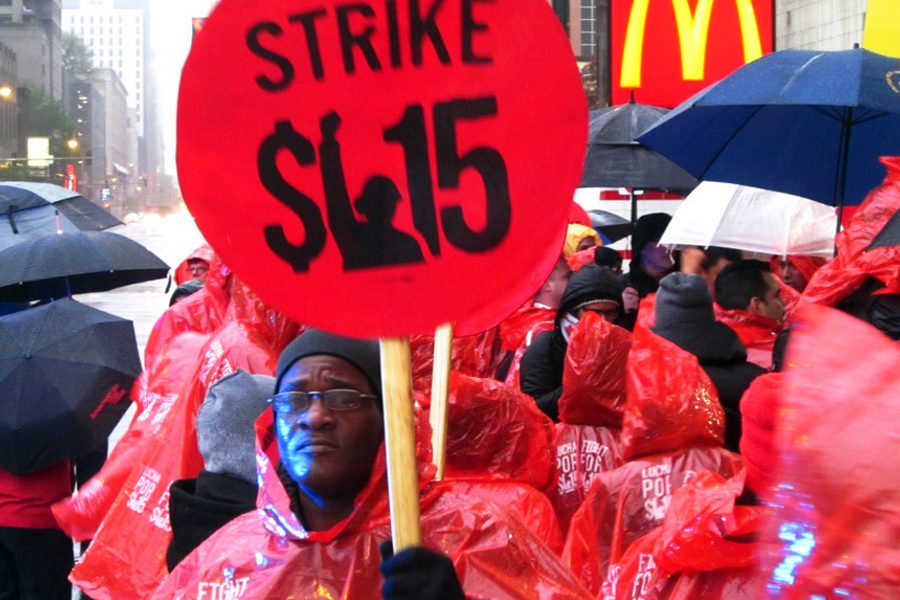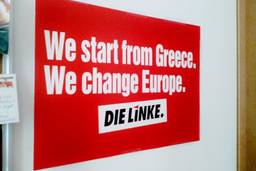
It’s 6 a.m. in Chicago, and the bitingly cold, drizzly weather seems oblivious to the fact that it’s May 15th. And yet, a crowd of more than 100 people wearing red ponchos has formed outside of a McDonald’s restaurant downtown, where they’re dancing to mariachi music.
“Fifteen and a union!” cries someone over a bullhorn.
Today, these protesters have joined fast-food employees in an estimated 150 American cities who walked off the job, according to organizers from the two-year-old Fight for 15 campaign. They’re demanding a $15-an-hour minimum wage and the right to form a union without retaliation. And such momentum isn’t limited to the United States. Workers have staged strikes or other actions to demonstrate global solidarity in cities on six continents.
In Chicago, workers striking at McDonald’s, Burger King, and Wendy’s traveled downtown to the Rock N Roll McDonald’s — a colossal restaurant-museum that was once one of the busiest McDonald’s restaurants in the country — accompanied by many fellow fast-food workers who were not on strike, but were still demonstrating for the same demands.
“I’m out here because we’re sick and tired of the poverty wages that they’re giving us,” says Adriana Alvarez, who works at a McDonald’s on the South Side of Chicago. “We’ve got people who’ve worked there 10, 15 years and they’re still getting $8.50 an hour. It’s unfair.”
Alvarez heard about the Fight for 15 campaign this year after an organizer spoke with her in the parking lot of her workplace. “Ever since then … I got really involved,” she says, noting that this is her first time on strike.
The campaign to win $15 an hour for fast-food workers has no official history. The first major demonstration, though, took place in November 2012, when workers in New York City walked off the job on a one-day, non-union strike — the now-signature move of the Fight for 15 campaign, which is backed by the Service Employees International Union. The New York Times called it “the biggest wave of job actions in the history of America’s fast-food industry.”
On August 29, 2013, the first nationally coordinated strikes took place in 60 cities; a few months later in December, fast-food employees walked off the job in 100 cities. As for today’s events, though no official count has been made, organizers say they planned walkouts in 150 American cities along with solidarity actions in more than 30 other countries — making it the largest event to date of the fast-food worker campaign.
As the movement has gained more media attention, debate around raising the minimum wage has surfaced on a policy level, too. The Vermont legislature voted this week to hike the state minimum wage up to $10.50 an hour, so far the highest in the country. In Seattle, Mayor Ed Murray is backing a $15 municipal minimum wage, more than $5 more than the current minimum. And President Obama himself recently went so far as to push—but fail to pass — an increase in the federal minimum wage from $7.25 to $10.10.
Activists credit the national Fight for 15 campaign for many of these initiatives, citing the fact, for example, that Obama announced his minimum wage agenda on the eve of the December strikes. They also point out that Murray came out with his plan for Seattle’s increase “quite late in the game.”
According to Jess Spear of Seattle’s 15 Now campaign, “There was a number of factors that led to [Murray’s plan], one of which, of course, is the brave fast-food workers who went out on strike in May 2013 here in Seattle, and then they did that again in August.” Spear notes that both actions took place “during an election year for the City Council seats in Seattle as well as the mayoral election.”
Seattle fast-food workers went out on strike again today, in conjunction with workers in New York, Miami, Orlando, Pittsburgh, St. Louis, Boston and Phoenix, among other cities.
Meanwhile, the global strikes and actions, which included protests in Switzerland, the Philippines, Japan and New Zealand, were coordinated earlier this month at an international conference in New York City called by the federation of unions known as IUF (International Union of Food, Agricultural, Hotel, Restaurant, Catering, Tobacco and Allied Workers’ Associations).
One of the conference’s attendees, Joe Carolan, who helped organize demonstrations in Auckland, New Zealand, said in a statement, “New Zealand is one of very few countries that have union agreements covering fast food workers. Many of the conditions workers in other countries are struggling to win — we have already achieved here. We are taking action today to support Fast Food workers in the [United States] and other countries who are fighting for these same conditions.”
In response to the protests, McDonald’s spokesperson Heidi Barker Sa Shekhem contends that the hamburger chain offers “competitive pay based on the local marketplace and job level”.
She continues, “McDonald’s and our owner-operators are committed to providing our respective employees with opportunities to succeed, and we have a long, proven history of providing advancement opportunities for those who want [them].” She also notes that “approximately 80 percent of our global restaurants are independently owned and operated by small business owners, who are independent employers that comply with local and federal laws.”
Although one of the demands of today’s international action is for the right to form a union without retaliation from the company, Barker Sa Shekhem maintains that McDonald’s workers already have that: “We respect the right of employees to choose whether or not they want to unionize.” Organizers with the Chicago Fight for 15 say that this is not the reality, at least when it comes to many franchises around the country.
Barker Sa Shekhem adds that “to right-size the headlines, the events taking place [today] are not strikes. Outside groups have traveled to McDonald’s and other outlets to stage rallies.”
While it is true, however, that in Chicago workers who walked off their job this morning were joined by community supporters at a central McDonald’s, several workers confirmed that they were scheduled to work at either McDonald’s or Burger King today but had not gone to work in order to strike.
One of these strikers, Regis Harris, was a no-show at his Burger King job at 78th Street and Columbus Drive, where he hasn’t had a raise in a year. Harris “decided to come on out” because “you can’t live off [minimum wage]. You can’t even pay the heat in the wintertime in the house … for $8.50 an hour.”
He says this uncertainty requires him to keep up several jobs at a time: lawn care, snow removal, painting, dry-walling and electrical work, to name just a few. He believes $15 an hour would help him feel more secure and independent.
“I could pay my bills. I could make my own bills,” he jokes. “It would help everybody out.”







